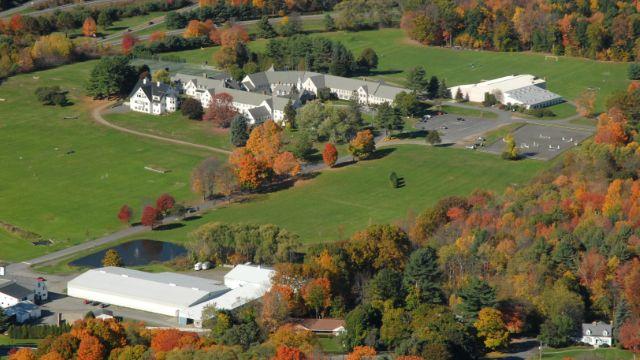- Welcome
- Academics
- Admissions
- Alumnae, Advancement & Giving
- Family Resources
- Diversity, Equity & Inclusion
- Health & Wellness
- Athletics & Equestrian
- Debate & Public Speaking
- Performing & Visual Arts
- Summer Programs
- Live Stream
Studying the visual arts is an interactive hands-on learning experience where students learn both the concepts and skills that are common to all visual arts disciplines. Students engage their creative sensibilities on a daily basis, in tandem and in concert with their academic lives.
Stoneleigh-Burnham students take at least two trimesters of arts offerings per year.
Art 7
This course is an introduction to visual art through an art historical lens. Students learn about and create work in a variety of art mediums while concurrently investigating cultural, historical and geographical contexts of the art forms. In this class students work both independently and collaboratively to explore how people have expressed their traditions, beliefs, identities and daily actions through art, and experiment with using symbolism to express their own cultural and personal identities. (MS)
3d DESIGN 7
Continuing to work with the use of symbolism and visual narrative, students will break from the page and explore three-dimensional form. Using paper, cardboard, clay, wire, and found material students will investigate strategies of occupying and moving through three-dimensional space. (7th grade)
Design & Color
This foundation course focuses on an introduction to the Elements of Art and Principles of Design. Students complete a sequence of projects related to contemporary topics that ask them to apply their understanding of concepts and techniques, and think critically about their own work, the work of their peers, and historical works of art. Students explore how images work, how they are constructed, and what they mean, and gain practice writing about art. This class highlights creative problem solving, interdisciplinary learning, and critical thinking in the visual arts. (8th & 9th grades)
Intro to Drawing & Painting 8
This elective is open to eighth graders who have completed Design & Color and offers an introduction to drawing and painting techniques on paper. Students will use pencil, ink, acrylic, and watercolor to create both observational and invented studies and compositions. (MS)
ANIMATION
This elective is an introduction and exploration of animation primarily through hand-drawn animation. Students will learn the basics of animation but have room to experiment and follow their ideas. The course uses iPads and a Pencil/Crayon to create digitally drawn animations and understand the tools and platforms for digital animation. (MS/US)
Ceramics
In this course students learn the fundamentals of hand-building, throwing on the potter's wheel, underglazing, glazing, carving, and other decoration techniques. Students work on a variety of projects, from simple forms, to elaborate functional and sculptural pieces. (MS/US)
Drawing
FILM/VIDEO
This elective introduces students to a variety of basic filmmaking techniques, tools, and topics, from scripting and cinematography, to directing, video editing, and color grading. Students will learn narrative and concept development, as well as context for their practice in a brief history of lens-based media and contemporary examples. (US)
PAINTING
PAPER MAKING/BOOK MAKING
Students will explore several paper making techniques that utilize recycled paper goods, found natural materials, as well as applications of pigment and use of natural dyes. After an inquiry into the historical and contemporary practice of book making, students will learn several bookbinding techniques and projects that consider content, user experience and overall aesthetic— even creating a small book made from paper samples they made at the beginning of term. (US)
PHOTO
In this elective, students use digital SLR cameras to learn photography techniques using traditional and contemporary concepts and skills. Students learn how to use their cameras, compose photographic images, and develop their personal photographic vision. The course material is presented within a cultural and historical context of the form, from modern to contemporary. Emphasis is on photographic practice, with some research and writing assignments intended to deepen understanding of the material. Students work in black and white to focus on formal qualities, structure, and contrast. (US)
PRINTMAKING
This elective explores a variety of methods for making monoprints and carved block prints using water soluble oil- and water-based inks on a variety of surfaces. Art historical and contemporary practices act as context for each technique introduced. (US)
PROPS & SET
In collaboration with the winter musical Once Upon a Mattress, this course will introduce students to various set building strategies and materials. Students should come ready to adorn the stage with their creations! An interest in painting, drawing, and building imaginative worlds is key. (MS/US)
SCULPTURE
Weaving
This course explores weaving on a four harness loom. Students will become familiar with the parts of the loom, weaving terminology, basic weave structures, color effects, reading drafts, and fiber types. Students will weave and finish three items over the course of the trimester. (MS/US)
International Baccalaureate (IB) ART
In the first year of this course, students investigate and explore art from diverse cultures and time periods. Students plan and create studio artworks with an emphasis on documenting their influences through research and keeping a sketchbook, known as the visual arts journal. Students learn to formally analyze art and will frequently compare and critique art throughout the year. The class will visit galleries and museums at least three times during the year. As the year progresses, each student is encouraged to find and develop their own voice in the visual arts. (US)
In the second year of this course, students further develop their personal style to create a realized body of work. They will continue to work in their visual arts journal, documenting their process of creating and investigating art, including sketches, planning notes and expressive intentions as well as connections to pertinent works that have influenced the student’s work. In March, there is a formal exhibit of each student’s work which they will install. Each student will complete a Comparative Study, Process Portfolio, and Exhibition documentation and statements for submission to the IB. (US)



